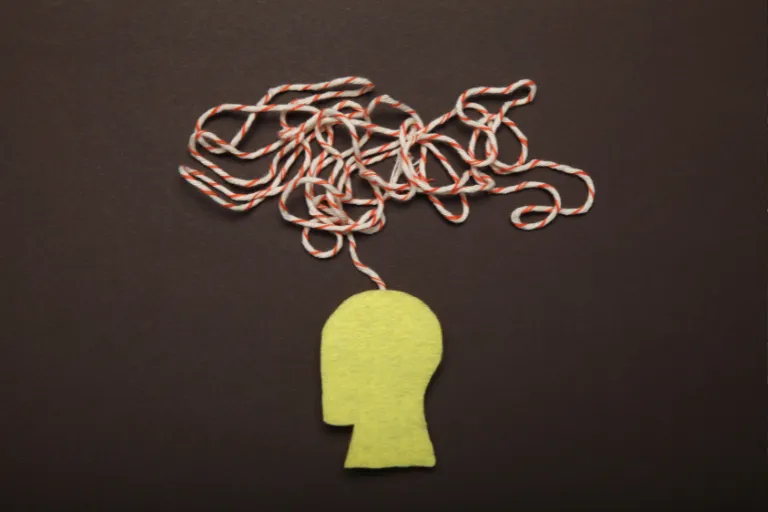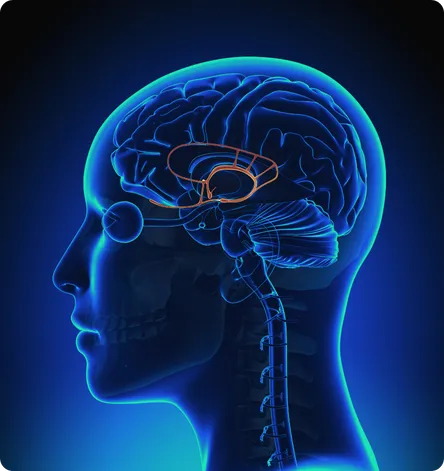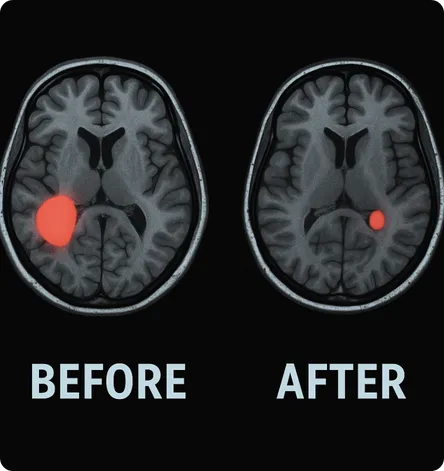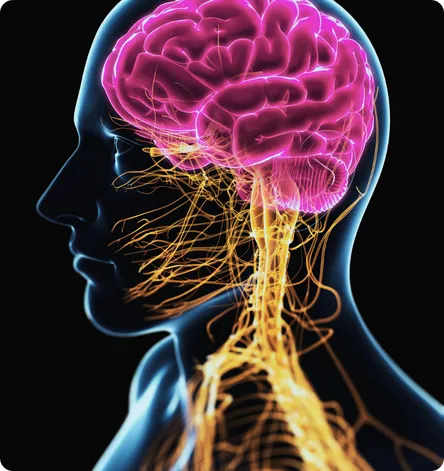If you’ve been told “it’s just stress” or “try to relax more” – but your racing heart and spinning thoughts persist, this could change everything…

7 Scientific Discoveries About Your Anxiety Your Doctor Never Learned in Medical School
If you’ve been told “it’s just stress” or “try to relax more” – but your racing heart and spinning thoughts persist, this could change everything…
Your heart shouldn’t pound during normal conversations.
Simple decisions shouldn’t feel overwhelming and paralyzing.
You shouldn’t need to rehearse basic interactions in your head.
Living in constant “alert mode” isn’t normal, no matter what anyone says.
#1. Your Brain Has Two “Operating Systems” – And Nervousness Hijacks the Primitive One
Your brain has two processing systems: the “thinking brain” (prefrontal cortex) and the “survival brain” (limbic system).
In healthy people, the thinking brain stays in control. But chronic nervousness hijacks your survival brain, putting it in permanent control.
It’s like having a security guard (survival brain) who’s supposed to only work nights, but instead takes over the entire building 24/7.

This survival brain can’t distinguish between real danger and perceived threats.
This is why you can lie awake at 2 AM, staring at the ceiling, logically knowing there’s nothing wrong – but your heart is still racing like you just narrowly escaped a car accident.
#2. Nervousness Changes Your Brain Structure (But It’s Reversible)
Chronic nervousness physically reshapes your brain. Brain scans show an enlarged amygdala (fear center) and smaller prefrontal cortex (logic center).

Think of it this way: if you spent three months only using your left arm, it would bulk up while your right arm weakened. Your brain does the same – every time you catastrophize at 3 AM, you’re “lifting weights” with your fear pathways while your calm pathways atrophy.
The hopeful part: Harvard researchers tracked nervousness patients for 8 weeks. When patients consistently activated calm pathways, their brain scans transformed – the swollen amygdala shrank back to normal, the prefrontal cortex lit up bright and strong again.
#3. Your Body Creates Nervousness Before Your Mind Knows What’s Happening

Most people think: “I see something scary → I think anxious thoughts → my body reacts.”
But nervousness actually happens in reverse: your body reacts first, then your mind creates stories to explain the physical sensations.
Your nervous system scans for threats 11 million times per second. When it detects something “off” – maybe your boss’s tone or your partner’s facial expression – it triggers physical symptoms instantly.
Only then does your conscious mind notice the racing heart and think: “Why am I anxious?”
This is why trying to “think your way out” feels like trying to convince yourself you’re not hungry when your stomach is growling.
#4. Worry Is Contagious Through “Neural Mirroring”

Your nervous system automatically syncs with people around you through “emotional contagion.”
If you live with someone who checks their phone obsessively and sighs heavily throughout dinner, or work where everyone’s shoulders are permanently hunched, your nervous system learns to match their activation level. You literally carry their worry in your body.
This explains why you might walk into your childhood home and instantly feel your chest tighten, even though you’re just watching TV. Your nervous system picks up the collective stress level.
#5. Your Childhood Nervous System Still Controls Your Adult Worry

If you grew up in an unpredictable environment, your nervous system calibrated for danger – even if you’re now safe.
Think of it like a car alarm installed in a high-crime neighborhood. Even if you move to the safest suburb, the alarm stays at maximum sensitivity.
Maybe your mom checked locks three times before bed. Maybe you walked on eggshells because you never knew Dad’s mood. Maybe you were the “responsible one” keeping siblings quiet so Mom wouldn’t have a breakdown.
Any chronic unpredictability during development can leave your nervous system stuck in high-alert decades later.
#6. Worry and Autoimmune Diseases Share the Same Root Cause

Your vagus nerve controls both stress response AND immune regulation. When vagal tone is weak:
- Your stress response becomes overactive (worry)
- Your immune system becomes overactive (inflammation/autoimmunity)
You can’t eat pizza without bloating. Your thyroid goes haywire. You get mysterious skin rashes. You catch every office cold while others stay healthy.
Most doctors send you to five specialists for five different diagnoses. But they’re all symptoms of the same root problem: poor vagus nerve function.
#7. Your Stress Can Be Calmed by Activating the Vagus Nerve

Deep inside your body lies a nerve that acts like a control switch for stress.
When it’s activated, your nervous system shifts out of fight-or-flight and into a calm, balanced state.
When it’s underactive, stress runs wild — leaving you tense, restless, and unable to shut down anxious thoughts.
Scientists have discovered that by gently stimulating this nerve, you can reset your body’s stress response — almost like flipping a switch from panic to peace.

The Missing Piece Your Doctor Never Learned
Here’s what connects all 7 truths: your vagus nerve controls every single one of these processes.
- It regulates which "operating system" your brain uses
- It determines your brain structure through neuroplasticity
- It controls your body's stress signals
- It manages neural mirroring and stress contagion
- It carries your childhood nervous system programming
- It coordinates your immune and stress responses
- It works through subtle electrical signals that shape how calm or stressed you feel
Scientists call it the ‘superhighway’ between your body and brain.
It’s the longest cranial nerve in the body — running from your brainstem down through your heart, lungs, and gut.
And because it touches nearly every major organ, it influences everything from your heartbeat… to your breathing… to how your brain rewires itself after stress.
In short: when this one nerve is healthy and active, all 7 of these worry-creating processes begin to normalize automatically.
Most doctors learned to treat worry as a brain chemistry problem…
But the real control center is your vagus nerve.
When this one nerve functions properly, all 7 of these worry-creating processes normalize automatically.
What if you could act on all 7 of these breakthroughs — in minutes a day? Here’s how thousands are already doing it.
The Technology That Targets All 7 Root Causes
What if there was a way to directly strengthen your vagus nerve using the same precise frequencies that researchers use in clinical studies?
Nurosym™ is already being used by thousands of people — and it’s the only at-home device designed around all 7 discoveries.
Instead of hoping meditation or medication will eventually work, you can directly stimulate the nerve that controls all worry-creating processes.

How Nurosym™ Addresses Each Scientific Truth
- Truth #1 (Two Operating Systems): Vagal stimulation shifts control back to your prefrontal cortex
- Truth #2 (Brain Structure): Consistent use promotes neuroplasticity that rebuilds healthy brain patterns
- Truth #3 (Body-First Worry): Works at the nervous system level where worry actually originates
- Truth #4 (Neural Mirroring): Strengthens your nervous system so it doesn't absorb others' stress
- Truth #5 (Childhood Programming): Overwrites old nervous system patterns with new, healthy responses
- Truth #6 (Immune Connection): Activates vagal pathways that regulate both stress and immune function
- Truth #7 (Precise Vagus Nerve Targeting): Uses precisely calibrated signal proven to activate the vagus nerve and promote calm states
The Clinical Evidence
- 177 studies analyzing 6,300+ participants confirm safety and efficacy
- 50+ peer-reviewed studies specifically on this technology
- 4 million completed sessions with an excellent safety record
- 1,000+ healthcare professionals using it clinically
- Harvard, UCLA, Yale and 100+ other research institution collaboration on research protocols
What You Experience
Week 1-2: Nervous system begins responding to targeted stimulation
Week 3-4: Noticeable reduction in physical anxiety symptoms
Month 2-3: Anxiety responses become less frequent and intense
Month 3+: New nervous system patterns become automatic
Customer Testimonials

“My anxious thoughts and elevated stress levels are gone. I’m able to control it much better. I would recommend it to everyone.”
– Tijana, 6 months daily use

“What I have noticed is that it instantly soothes my nervous system. It gradually calms you down. Five star rating for me.”
– Derek, Former anxiety sufferer
Simple Daily Protocol
- 30 minutes daily – clip device to ear while doing normal activities
- Gentle electrical stimulation – comfortable, barely noticeable sensation
- Automatic nervous system retraining – no conscious effort required
- Cumulative improvements – benefits build over time

Now You Finally Understand What Anxiety Really Is
You can address the actual scientific root causes of your anxiety…
Or get every penny of your money back.
For years, you’ve been handed the same recycled advice: “just think positive thoughts,” “try deep breathing,” or “maybe you need stronger medication.” Meanwhile, your anxiety kept getting worse because no one was addressing what’s actually happening in your nervous system.
Now you can use a solution based on cutting-edge neuroscience that addresses all 7 root causes simultaneously.
Imagine walking into your next work meeting with steady confidence instead of a pounding chest. Picture falling asleep within minutes instead of staring at the ceiling. Think about having difficult conversations without your whole body going into fight-or-flight mode.
Your order is completely protected by their 30-day money-back guarantee.
If you don’t experience significant improvements within 30 days, they’ll refund every dollar.
That’s a full month to experience what happens when you work with your nervous system’s actual science instead of against it.
You’ve already tried everything else – $200 therapy sessions, medications with awful side effects, meditation apps that made you more frustrated.
With overwhelming scientific evidence supporting this approach, you finally have an anxiety treatment that actually makes sense.
Anxiety has controlled you long enough.
Click below to take back your calm.
The article does not in any way constitute as medical advice. Please seek consultation with a licensed medical professional before starting any treatment. This website may receive commissions from the links or products mentioned in this article.
RÉFÉRENCES:
- Bonnet, M. H., & Arand, D. L. (2010). Hyperarousal and insomnia: State of the science. Sleep Medicine Reviews, 14(1), 9–15. https://doi.org/10.1016/j.smrv.2009.05.002
- Bremner, J. D., Gurel, N. Z., Wittbrodt, M. T., Shandhi, M. M. H., Nye, J. A., Kilts, C. D., Ritchie, J. C., Braddy, B. A., Shah, A. J., Vaccarino, V., Jones, D. R., & Inan, O. T. (2020). Transcutaneous vagal nerve stimulation blocks stress-induced IL-6 and IFN-γ in posttraumatic stress disorder: A double-blind, randomized, sham-controlled trial. Brain, Behavior, & Immunity – Health, 9, 100138. https://doi.org/10.1016/j.bbih.2020.100138
- Chalmers, J. A., Quintana, D. S., Abbott, M. J.-A., & Kemp, A. H. (2014). Anxiety disorders are associated with reduced heart rate variability: A meta-analysis. Frontiers in Psychiatry, 5, 80. https://doi.org/10.3389/fpsyt.2014.00080
- Chouchou, F., & Desseilles, M. (2014). Heart rate variability: A tool to explore the sleeping brain? Frontiers in Neuroscience, 8, 402. https://doi.org/10.3389/fnins.2014.00402
- Cooper, T. M., McKinley, P. S., Seeman, T. E., Choo, T.-H., Lee, S., & Sloan, R. P. (2015). Heart rate variability predicts levels of inflammatory markers: Evidence for the vagal anti-inflammatory pathway. Brain, Behavior, and Immunity, 49, 94–100. https://doi.org/10.1016/j.bbi.2014.12.017
- Kim, A. Y., Marduy, A., de Melo, P. S., Gianlorenço, A. C., Kim, C. K., Choi, H., Song, J.-J., & Fregni, F. (2022). Safety of transcutaneous auricular vagus nerve stimulation (taVNS): A systematic review and meta-analysis. Scientific Reports, 12, 22055. https://doi.org/10.1038/s41598-022-25864-1
- Szeska, C., Eippert, F., Reicherts, P., & Büchel, C. (2020). Promoting long-term inhibition of human fear responses by non-invasive transcutaneous vagus nerve stimulation during extinction training. Scientific Reports, 10, 15229. https://doi.org/10.1038/s41598-020-58412-w
- Tracey, K. J. (2002). The inflammatory reflex. Nature, 420(6917), 853–859. https://doi.org/10.1038/nature01321
- Tracey, K. J. (2009). Reflex control of immunity. Nature Reviews Immunology, 9(6), 418–428. https://doi.org/10.1038/nri2566
- Ylikoski, J., Pirvola, T., Lehtimäki, J., Mäkitie, A., & Aarnisalo, A. A. (2020). Stress and tinnitus: Auricular vagus nerve stimulation attenuates tinnitus-triggered stress reaction. Frontiers in Psychology, 11, 570196. https://doi.org/10.3389/fpsyg.2020.570196
- Zhang, S., Zhao, Y., Qin, Z., Han, Y., He, J., Zhao, B., Wang, L., Duan, Y., Huo, J., Wang, T., Wang, Y., & Rong, P. (2024). Transcutaneous auricular vagus nerve stimulation for chronic insomnia disorder: A randomized clinical trial. JAMA Network Open, 7(12), e2451217. https://doi.org/10.1001/jamanetworkopen.2024.51217
- Geng, D., Liu, X., Wang, Y., & Wang, J. (2022). The effect of transcutaneous auricular vagus nerve stimulation on HRV in healthy young people. PLOS ONE, 17(2), e0263833. https://doi.org/10.1371/journal.pone.0263833
- Forte, G., Favieri, F., Leemhuis, E., De Martino, M. L., Giannini, A. M., De Gennaro, L., Casagrande, M., & Pazzaglia, M. (2022). Ear your heart: Transcutaneous auricular vagus nerve stimulation on heart rate variability in healthy young participants. PeerJ, 10, e14447. https://doi.org/10.7717/peerj.14447
- Stavrakis, S., Elkholey, K., Morris, L., Niewiadomska, M., Asad, Z. U. A., Humphrey, M. B., & others. (2022). Neuromodulation of inflammation to treat heart failure with preserved ejection fraction: A pilot randomized clinical trial. Journal of the American Heart Association, 11(3), e023582. https://doi.org/10.1161/JAHA.121.023582
Share via:


